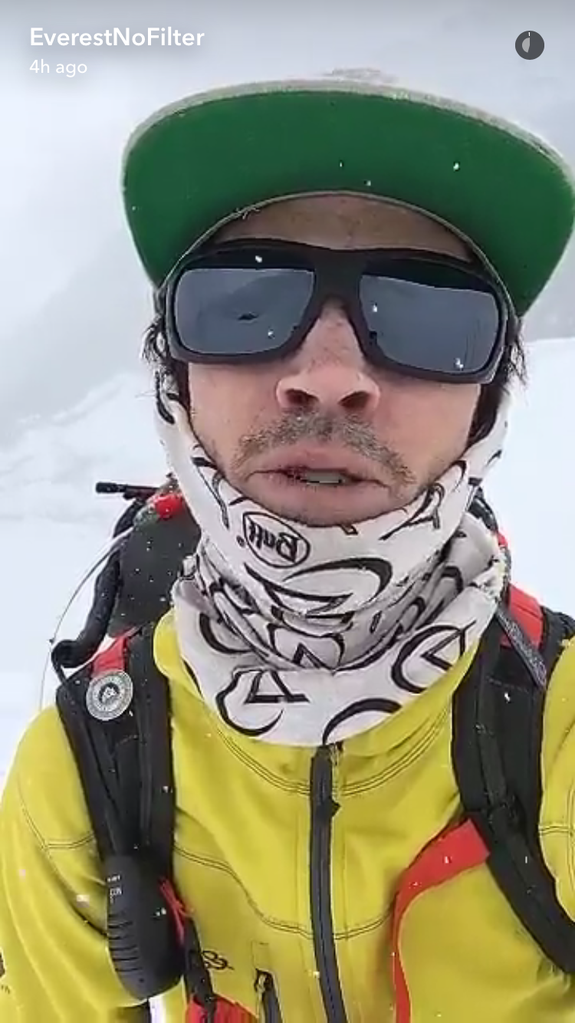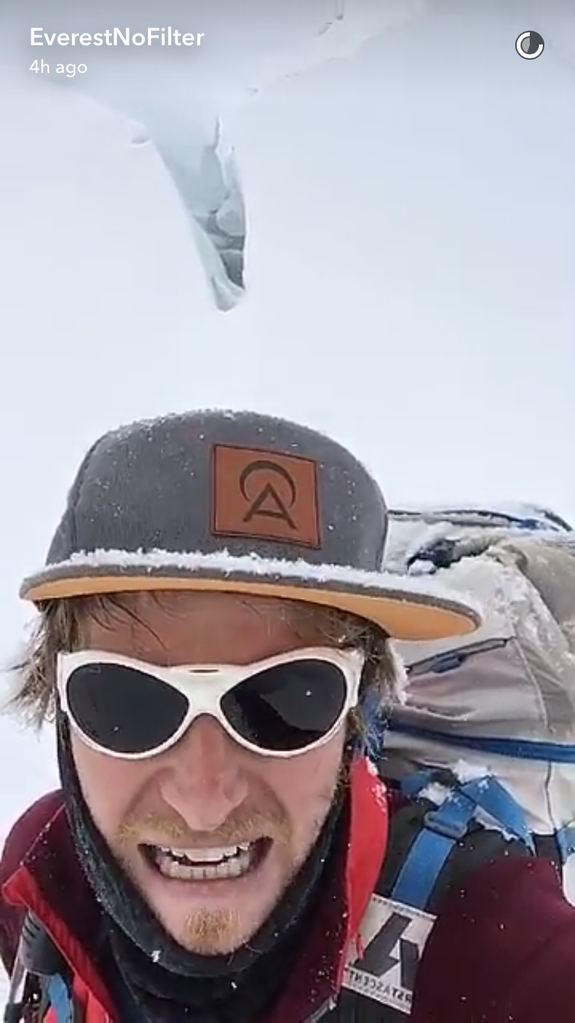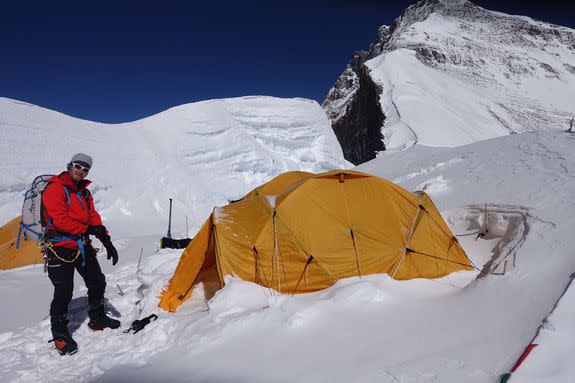8 pro tips for climbing Mount Everest from the guys who Snapchatted their journey

Next time you're whining about the ~struggles~ of trying to capture the perfect winter Snapchat to add to your story, think of Adrian Ballinger and Cory Richards — two badass mountaineers who used Snapchat to document their climb up Mount Everest last year — and toughen up.
Before they attempt to summit Everest again this April, the two legendary adventurers — who became fast friends after meeting seven years ago in the Himalayas — stopped by SXSW to chat about the tech that saves their lives during the climbs and give inquiring minds some insight on what it's really like to take on the world’s tallest mountain.
SEE ALSO: Now you can climb Mount Everest in VR
In May 2016, the partners embarked on a climb without supplemental oxygen. But when Ballinger, who previously summited Everest six times (with oxygen,) neared 28,000 feet above sea level, he was advised to head back to base camp due to poor health.
Richards carried on, achieving his first Everest summit and becoming one of around 200 people to have successfully climbed Everest without using additional oxygen, but unfortunately, due to some technical difficulties, when he reached the peak he was unable to Snapchat his epic view.
This year, Ballinger explained the primary goal for the two is to summit without supplemental oxygen, while, of course, having loads of fun and hopefully grabbing that glorious Snapchat moment Richards was denied last year.
Between the popular social media platform and Strava — a biometric data-driven app that tracks their heartbeats, miles walked and other health-related statistics — the climbers plan to use the best of tech and social storytelling to chronicle their excursion in a never-before-seen way.
After hearing the experienced climbers describe the key technology and factors that make achieving their goal possible, Mashable compiled a list of fascinating Everest pro tips — from the jaw-droppingly costly price of internet to the shockingly gross storage of bodily fluids.
Here are some things you should know should you hope to scale Everest and document your trip:
The internet costs A LOT up there
Snapchatting up Everest is no cheap feat. In fact, Ballinger explained that last year, the pair's internet bill was a whopping $23,000 — essentially as steep as the mountain itself. While I almost passed out upon hearing this news, Ballinger simply laughed and owned the massive but worthwhile charges, saying, "We killed it."
Bet that extra $50 you pay when you exceed your data limit doesn't seem so terrifying anymore.

Image: SNAPCHAT/EVEReSTNOFILTER

Image: SNAPCHAT/EVEReSTNOFILTER
Data will help you understand what's really going on
While Snapchat serves as a more lighthearted form of entertainment for the two, allowing them to preserve and share monumental memories from the mountain, Strava aids in their safety, updating them — along with their doctors and coaches back home — about their health.
"We feel like the two platforms — Strava and Snapchat — work really well together because they show two really different sides of what we do," Ballinger explained. Without Strava's geospatial data, it would be almost impossible for the men to make sense of their physical activity on the mountain.
"We go a mile and it takes four and a half hours," Ballinger said, but once you use the app to "see the data, look at the heart rate, grade of the slope and do some calculations, you figure out that’s like the equivalent of running five-and-a-half-minute miles for four hours."
"It’s basically an Instagram or Snapchat for the athletic community but rather than stripping pictures and videos you’ve got all sorts of backup data to show what’s actually happening," Richards added. "It’s a more robust and scientific social media."
Special gloves are VERY important
In Richards' mind, the gloves you wear could either make or break your entire Everest experience.
"Some people don’t think about this, but something that’s massively important to me is the gloves you have on," he explained. When it's negative 25 degrees outside and the wind is whipping at 20mph, "the last thing you want to do is take your gloves off," he said, so you'll need special tipped gloves to use your phone.

Image: eddie bauer
External battery packs are your heroes
For all those who fear the menacing 10% battery warning as much as death itself, it feels like external battery packs save lives on the regular. But on Everest they're actually essential — just ask Cory Richards, he knows.
"Cory summited this past year without oxygen," Ballinger said about his climbing partner. However, when he reached the top of the mountain, he was in for some very troubling news — his phone was dead. 😱 "Cory did not take a snap from the summit because he took his phone out, pushed the button and got the wheel of death right as the phone shut down," he explained explained. Ballinger had been carrying the external batteries all season but went back down the mountain before reaching the top, taking the power sources with him.
When Richards successfully reached Everest's peak and the heartbreaking wheel of death showed itself, he admitted he considered straight-up throwing his phone off the mountain. However, he ultimately decided it was more important to preserve the other content on the device and resisted the urge. "I wasn’t mad," he said, "it was more of like a Tom Cruise moment in Top Gun where he takes the dog tags and chucks them."
Everest can be as social as you want it to be
You may think a two-and-a-half-month climb up a very cold mountain would be an extremely solitary experience, but according to Ballinger, it doesn't have to be. While you'll undoubtedly spend a lot of time alone with your thoughts, the climber compared base camp to summer camp!
"Some things are really serious when you’re higher up, but when you come down everyone just wants to let off steam," he explained. When the two aren't busy brushing their teeth, having dance parties or judging who has grosser looking hair, they're exploring the camps.
With different camps spread out over a 25 to 30 minute walk, climbers have the option to do whatever they feel like, such as eating Korean food for lunch at the Korean camp, grabbing some vodka at the Russian camp or popping by the Italian camp to steal some prosciutto and mozzarella, for example. Sounds pretty awesome, doesn't it?

Image: eddie bauer
You sleep with a bottle of pee (I am unfortunately not joking)
Bad news, prospective Everest climbers — sleeping arrangements are definitely not ideal, nor are they comfortable. "The reality is it’s so cold up there that anything liquid or electronic actually has to be inside your sleeping bag," Ballinger described.
"So you’re in a mummified sleeping bag and it’s completely full of stuff ... your boots are in there because your boots would freeze otherwise, your water is in there, every battery you have — sometimes we carry like 10 or 12 pounds of batteries — our satellite internet, phones, cameras," he went on. "We even have our pee bottles in there because it’s too cold to go outside to pee."

Image: eddie bauer
I mean to me, cuddling a bottle of pee at night sounds pretty nasty, but a seasoned professional like Richards is all for it. "Pee is actually a great source of heat once it's outside of you," he said. In fact, Richards makes the most of his pee bottle by putting it down at the bottom of his sleeping bag to keep his feet warm.
If you're attempting to climb without supplemental oxygen, it's not going to feel great
Ballinger described the feeling of scaling the mountain without oxygen as "pure suffering." While both men admit it's hard to even imagine the severity of the discomfort, he compared the feeling of breathing thin air high on the mountain to laboriously breathing through straws. "I think the best way to do it if you want to try it at home is to run around your block or exercise normally — that’s like sea-level," he said. Breathing through three straws and running around the block a few times is like 10,000 or 12,000 ft, and repeating the activity with one straw is like 20,000 ft.
If you're looking to feel high altitude, "go try with a coffee stirrer," he explained.
The video above shows several Everest Snapchats from Richards where he can be seen speaking in between strained breaths. "You can hear it in some of the snaps. It’s shallow, labored breathing," he said. "When you’re not acclimatized, I think the easiest way to explain what it feels like to be at altitude is like the worst hangover you can imagine and still having to get out of bed and go work out — all of the symptoms are the same, confusion, dehydration, headache," Ballinger added.
You'll want to buy ramen and Pop-Tarts in bulk
Welcome to college — errr wait, Everest! Once you embark on your climb an Everest diet isn't as healthy as you might imagine. Since fats and proteins are difficult to digest above 10,000 ft, sugars are your friend. "Some of the things you would normally be okay to eat, you can't digest," Richards explained. His go-to meal? "Lots of ramen."
Richards said the dorm room staple has tons of sugar in the noodles, tons of fluid in the broth and it’s salty. The dynamic duo have also been spotted Snapchatting Pop-Tarts on their journey, so Everest climbing sounds delicious.

Image: SNAPCHAT/EVERESTNOFILTER
Despite this amazing inside info, you shouldn't be attempting this perilous climb without a whole lot of training and experience. Even well-trained and experienced climbers can run into difficulty, which can be fatal. After Everest's 2016 climbing season, a total of six people reportedly died on the mountain, 18 died following an earthquake in 2015, and there are a ton of potential dangers climbers must face.
Be sure to follow along with videos and photographs of the April 8 expedition on Snapchat at EverestNoFilter.
